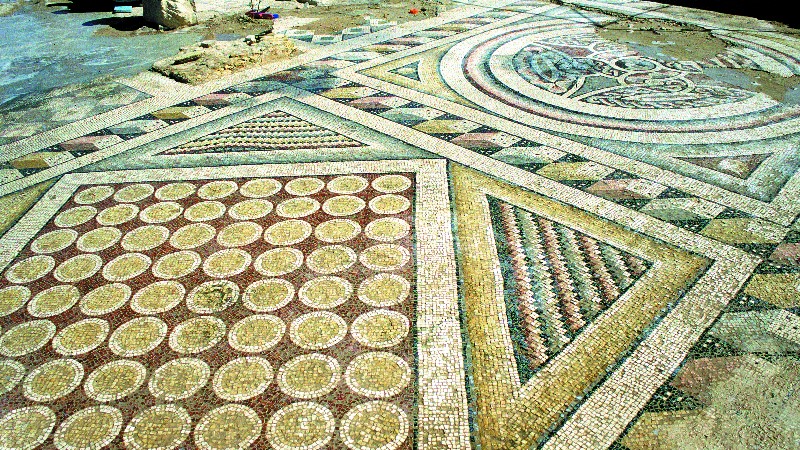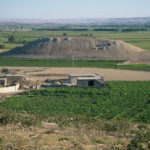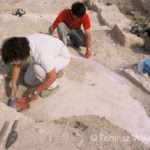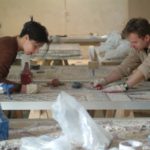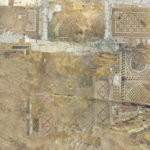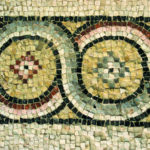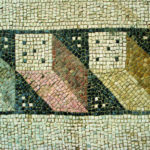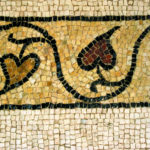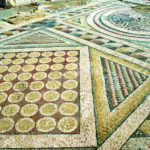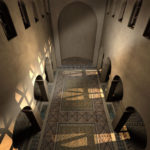Tell Amarna
-
Project name:
The work was conducted as part of rescue excavations related to the construction of the Tishrin Dam on the Euphrates
-
Type of site:
Settlement site
Location:
Syria
Northern Syria
Middle Euphrates ValleyGeographical/historical region: Euphratensis
Dating:
– From the Halaf period (6th millennium BC) through the Byzantine period (5th century AD)
Most interesting finds:
– Painted fragments of pottery vessels from the Halaf period
– Ceramic vessels from the Bronze Age
– Terracotta figurines from the Bronze and Iron Ages
– Cylindrical seal from the Bronze Age
– Oil lamps from the Hellenistic period
– Remains of an early Christian church
– Floor mosaics dated to the first half of the 5th century AD
History of research:
– Salvage excavations conducted by the mission from Université de Liège in 1991–1998.
– In 1998, the remains of a Byzantine church with mosaics were uncovered.
– In 2000–2001, the church was excavated by archaeologists and the mosaics were transferred to Damascus.
– From November 2004 to March 2005 fragments of mosaics were under conservation in Damascus.
Directors:
Önhan Tunca (Université de Liège)
Tomasz Waliszewski (Institute of Archaeology, University of Warsaw
Krzysztof Chmielewski (Academy of Fine Arts in Warsaw)
Description of the site and research:
During excavations conducted in Tell Amarna on the north of Syria by a team of Belgian archaeologists from the University of Liège, directed by Prof. Önhan Tunca, fragmentarily preserved ruins of a Byzantine church were found near the ancient remains of a 5 thousand-year-old settlement. These relics are dated to the end of the 4th century–beginning of the 5th century AD. Archaeologists and conservators from the Polish Centre of Mediterranean Archaeology of the University of Warsaw, under the direction of Dr. Tomasz Waliszewski and Dr. Krzysztof Chmielewski, were asked to cooperate in restoring and interpreting this find. Due to the threat posed to the excavation site by agricultural works the mosaics were raised up and deposited in the storerooms of the Direction Générale des Antiquités et des Musées of the Arab Republic of Syria.
Four years were needed to obtain the financial resources necessary for performing their conservation. Work conducted in Damascus in the autumn of 2004 and winter of 2005 by Polish, Syrian and Greek conservators was financed by the European Commission as part of the Culture 2000 program [Couleur de la chrétienté de l’Orient vers l’Occident. Une église du 5e siècle et ses mosaïques mises au jour à Tell Amarna (Syrie)].
An integral part of the project was an exhibition which was shown to the Belgian public in the Royal Museum of Mariemont in June 2005. The restored mosaics and other objects from the excavations were on display in the State Archaeological Museum in Warsaw from 31 August to 2 October 2005, after which they were returned to Syria.
Tunca, Ö., Waliszewski, T. & Koniordos, V. (Eds.) (2011). Tell Amarna (Syrie) V. La basilique byzantine et ses mosaïques, PEETERS, Louvain–Paris–Dudley (MA); (=Publications de la Mission archéologique de l’Université de Liège en Syrie, vol. 5).
Tunca, Ö., Waliszewski, T. & Koniordos, V., (Eds.) (2005). Tell Amarna in Syria. From the 6th millenium BC painted pottery to the Byzantine mosaics, Catalogue of the exhibition, Musée Royal de Mariemont (19.06–15.08.2005) – State Archaeological Museum in Warsaw (30.08–2.10.2005). Bruksela–Warszawa.
Tunca, O., Waliszewski, T., Koniordos, V. (2005). Tell Amarna w Syrii – Barwy chrześcijaństwa; Od malowanej ceramiki z VI tysiąclecia p.n.e. do bizantyjskich mozaik // Tell Amarna in Syria; From the 6th Millennium BC Painted Pottery to the Byzantine Mosaics. Culture Lab éditions, Państwowe Muzeum Archeologiczne, Bruksela–Warszawa.
Gallery:
-
1. General view of Tell Amarna in 2000 from the south. Widok ogólny Tell Amarna w 2000 roku, od strony południowej (fot. T. Waliszewski)
-
2. Excavations conducted in the apse of the church in 2000 uncovered two mosaic levels: on the right, the earliest level, probably from the 4th-century AD church, on the left, the later level dated to the first half of the 5th century AD. Wykopaliska przeprowadzone w absydzie kościoła w 2000 roku pozwoliły odsłonić dwa poziomy mozaik: na prawo najstarszy, prawdopodobnie z kościoła z IV wieku n.e., na lewo, młodszy, datowany na 1. Połowę V wieku n.e. (fot. T. Waliszewski)
-
3. Cleaning of the mosaic stuck onto a new foundation. Czyszczenie lica mozaiki naklejonej na nowe podłoże (fot. Tomasz Myjak)
-
4. View of the west mosaic decoration from the basilica in Tell Amarna dated to the first half of the 5th century AD, created as a result of computer rendering of many orthogonal photos taken when the mosaic was discovered in 1999. Widok zachodniej dekoracji mozaikowej bazyliki z Tell Amarna, datowanej na 1. Połowę V wieku n.e. Powstał on w efekcie komputerowej obróbki wielu zdjęć ortogonalnych, wykonanych w momencie odkrycia w 1999 roku (Virtual Shadow)
-
5. Motif of a circle chain encompassing the main field of the mosaic which adorned the floor of the sacristy. Motyw łańcucha z kół otaczał pole główne mozaiki zdobiącej podłogę zakrystii (fot. T. Waliszewski)
-
6. Motif of cuboids shown in perspective used in the decoration of the mosaic border in the southern aisle. Prostopadłościany w perspektywie, ten niezwykle dekoracyjny motyw zastosowano w bordiurze nawy południowej (fot. T. Waliszewski)
-
7. Ivy leaves on a yellow background of the mosaic border in the northern pastophorium. Zwój liści bluszczu został umieszczony na żółtym tle bordiury mozaiki w pastoforium północnym (fot. T. Waliszewski)
-
8. Floor mosaics from the southern aisle of the church after repeated cleaning in 2000. Mozaiki podłogowe z nawy południowej kościoła po wielokrotnym czyszczeniu w 2000 roku (fot. T. Waliszewski)
-
9. Visualization of the interior of the church, view of the central nave and the apse. Wizualizacja wnętrza kościoła, widok nawy głównej i absydy (Virtual Shadow)

